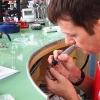Curved Glass - Easy Home Made Press
-
Recently Browsing
- No registered users viewing this page.
-
Topics
-
Posts
-
By luiazazrambo · Posted
It was £10 + min fee, total £16, could not leave it there. Its a Stanton A.D.2. http://stanton-instruments.co.uk/ -
Chief- The picture below shows the three parts from the dial side that are most useful to "fingerprint" a movement in conjunction with the diameter of the movement. That's why forum participants are always asking for dial side photos in posts asking for identification. As far as the setting lever screw, it actually sits loose in the main plate. The threads engage the setting lever below, and the elongated stem above the shoulder sticks through a hole in one of the bridge plates so that it's held captive if unscrewed all the way. So you may be fine as far as that goes.
-
So I found what I believe is the setting lever screw! Am I right in thinking the screw next to the click is the correct one for the setting lever? However if it is, it doesn't fit in the hole which I believe is for it! I can get the lever to sit nicely on the stem and line up with a hole, but the screw only goes as far as the shoulder and stops. It's as though the hole is too small! The dial side has been disassembled by the way, the other wheels are in my tray
-
When faced with say a pocket watch bridge which is cracked, silver soldering to repair is often the only option (hopefully someone wasn't there before hand with soft solder). I can generally do this succesfully and tidily with a small torch and miniscule pieces of silver solder, but on parts which were mercury amalgam gilded the heat can have have a deleterious effect on the finish. I keep wondering if there's a good way to refinish these - and despite having the needful items would rather avoid using the mercury process. In the past for electronic work I've gold plated PCBs but this involved gold potassium cyanide solution, which also doesn't realy belong at home. I've read that there are now safer alternatives but couldn't find more detail (and importantly how similar are the results to amalgam gilding, since I wouldn't want to refinish the whole watch). Pointers would be very welcome (and yes, I know solutions containing gold won't be cheap!) Alan
-
By Neverenoughwatches · Posted
The first one is an Unruh max stake for pushing out staffs
-






Recommended Posts